Your feedback is important to us
Please provide any feedback you have. Thank you!
Thank you!
Your feedback has been submitted.
 Individual Student Progress Report
Individual Student Progress Report
Please provide any feedback you have. Thank you!
Your feedback has been submitted.

See what skills are tested, understand your child's scores, and get ideas for how you can help at home.
Fourth graders should be independently reading increasingly challenging books, such as The Black Stallion, and poems, such as Shel Silverstein’s Whatif. They will discover a range of sentence structures and vocabulary words (like descended) that make them flex their reading muscles. As students discuss what they’ve read, they should be able to point to several examples in the text (also called evidence) to back up their ideas.
Kids need to explain their thinking, use details, and make connections between what they read and what they already know.
Fourth graders begin to make sense of information presented in maps, timelines, and charts in history or science readings. Students are expected to work independently, even on challenging assignments that require research.
At this age, children are also expected to understand some figurative language, such as idioms and expressions that aren’t literal. (Example: You’ve lost your mind!)
Watch how a teacher gets a fourth grader to explain what she’s learning as she reads.

At this age, kids are shifting from literal to abstract thinking. A literal thinker sees the Statue of Liberty as a lady holding a torch, but an abstract thinker recognizes that the statue represents freedom. As fourth graders come across more interesting sentences and words, new vocabulary and figurative language make reading more difficult but also more enjoyable. Note that figurative language can be especially challenging for students whose first language isn’t English because they must first learn and understand the literal meaning before interpreting the symbolism. (Imagine trying to understand He needs to get his ducks in a row if you were learning English!)
Fourth graders notice similarities and differences between the texts they read. They are developing an understanding of a narrator’s point of view (writing in the first person versus the third person) and an author’s purpose for writing.
In addition to stories, remember to read nonfiction texts. Pick something your child is interested in, maybe biographies, animals, or ancient civilizations. If a book or article is hard for your child to read, it’s perfectly fine to take turns reading aloud.
Here are some questions to get your child thinking. (Remember to ask Why? and How do you know?)
New words can get in the way of your child’s understanding. If your child pauses or stumbles on a word, he may not know its meaning. When your child comes across a word he doesn’t know, try this:
These 15 lessons at BeaLearningHero.org will give your child some practical experience reading a variety of subjects, finding evidence, determining the main ideas, and using clues in the text to improve his skills.
Watch how a teacher guides a fourth grader through the process of figuring out new words.

It’s important for fourth graders to build their academic vocabulary. These are words that are used often, in many subjects, but can be hard to define, such as confirm, prefer, and typical. Academic vocabulary is also more precise (for example, argued, exclaimed, or described instead of said). Check out this list for more academic vocabulary words to use with your fourth grader.
To increase your fourth grader’s academic vocabulary, introduce a new word every day. Tell your child the meaning of the new word, and have him look up another word that means the same thing. For instance, prefer means the same as would rather. Next, make up a sentence using the word. I prefer going for a walk instead of running today. For fun, help your child start a daily word journal. In a notebook or journal, have your child write the word and create his own sentence using the new word. Maybe he’d like to draw a picture to illustrate his sentence, too. The more memorable the sentence, the better!
Reading requires a combination of many skills: decoding, fluency, reading with expression, and comprehension. Kids also need to be steadily growing their knowledge about the world with every new article, book, and website they read. Ask your child’s teacher which of these skills are strongest for your child, and which areas need support. Then ask for the best ways you can help.
At this age, kids need to explain their thinking, use details, and make connections between what they read, hear, and write.
Fourth graders should be able to write to tell a story (narrative writing), to inform about a topic (informational writing), or to convince someone of their opinion (persuasive writing).
When they reach fourth grade, kids need to organize supporting information clearly. In any type of writing, fourth graders are expected to stay focused on their main idea and write each paragraph to build on the previous one. Your fourth grader’s writing should start with a strong introduction that grabs the reader’s attention and end with a clear conclusion that restates the main idea. She should include details and facts to support the main points in her writing. Read a few real-life examples of fourth grade nonfiction writing.
See what organized writing looks like in fourth grade.

Finally, your fourth grader’s punctuation, capitalization, and spelling should be (mostly) correct.
See what teachers are looking for in your fourth grader’s writing

At this age, kids should be good at catching their own capitalization, punctuation, and spelling mistakes and correcting them independently.
Part of the writing test is devoted to students fixing spelling and grammar errors and choosing which words fit best. Another part of the test asks kids to write and revise their own piece. All kids tackle the same topic when they write, but they are randomly given a narrative, informational, or opinion prompt. They must write in that style. Before the students start writing, the teacher leads a student discussion to help the kids remember what they already know about the topic. Students are then given sources to read that they can (and should) draw from in their writing.
When you help your child with writing, remember to celebrate his creativity and help him write his ideas clearly. Pay little attention to punctuation and spelling errors for now. (No need to take out the red pen!) Your child should improve on these as he moves through school.
Use these 12 tools at BeaLearningHero.org to understand what’s expected of a fourth grader when the test talks about informative/explanatory, argumentative, or narrative writing.
What’s missing in your child’s writing? Your child’s teacher can tell you, but it’s better to ask her to show you. Bring in a couple of your child’s writing samples and ask the teacher to point out what’s working and where your child’s writing needs work. The teacher may have other samples to share with you, too. Using specific examples can help your child’s teacher explain things clearly and lets you see specific ways to help your child with writing.
Your fourth grader should have good communication skills: saying things clearly, making eye contact when speaking or listening, and really listening to what others say. In general, fourth graders’ statements are well articulated, grammatically correct, and include precise vocabulary words when appropriate (like sprint instead of run).
At this age, kids start to sound like little adults. Even group discussions in class can proceed without too much help from the teacher. Students especially benefit from carefully listening to their peers’ ideas during discussions because it helps them adjust their own thinking, understand text, and gather ideas for writing.
Fourth graders work on their speaking and listening skills throughout the year in whole-class and small-group discussions. The state test, however, only covers listening skills (at least for now).
For this part of the test, students listen to a recording and answer questions about the main idea and supporting details to demonstrate their ability to listen attentively and capture the most important ideas and the reasons given to support those ideas.
Wondering what your child’s strengths and weaknesses are when it comes to speaking and listening? Ask the teacher! Is your child a great listener when he’s interested in a topic, but daydreaming when he’s bored? Does your child get caught up in a speaker’s first sentence and miss the details that follow? Your child’s teacher likely knows what your child needs to work on — and how you can help.
At this age, students are expected to work independently on research projects.
Fourth graders need to use their research skills to write — and they’re at the age where they don’t always get to focus on topics they’re interested in.
Kids should be able to read multiple sources to learn about a new topic, choose a main idea to write about, and select facts and details from their various sources that support their main idea.
Students gather information by reading books, reference materials, and online articles as well as from watching videos. While they’re researching, fourth graders are expected to take notes to help them prepare to write.
At this stage, kids may still need some guidance, but they should be getting better at recognizing which sources — and what information from those sources — will be most useful for their story, report, or opinion piece.
See fourth graders doing research for an essay.

Your child’s research skills are tested using multiple-choice questions. Kids are asked to select the best source of information on a topic. They’re also asked to decide the best place to put that information in their writing.
Fourth graders are also tested on putting their research skills into practice by selecting information and using it in a longer writing piece; this portion of the test is called the performance task.
This list of books that are good for fourth graders also comes with a guide to discussing each book! You’ll know exactly how to get your child chatting.
How are your fourth grader’s research skills? Ask! Your child’s teacher will be able to tell you about your child’s specific strengths and weaknesses when it comes to finding, choosing, and citing sources. And, if your child needs a little practice, your teacher can recommend sites where you can find age-appropriate articles and resources.
Fourth graders focus on two big areas of work: 1) the four operations — adding, subtracting, multiplying, and dividing multi-digit numbers; and 2) fractions — adding, subtracting, multiplying, and comparing fractions, as well as converting fractions to decimals.
In each of these areas, students learn both the why (concepts) and the how (procedures). For example, fourth graders are taught to recognize fractions with equal value. That’s a procedure. They also have to be able to explain why the fractions are equal. That’s a concept.
Fourth graders practice adding and subtracting numbers up to 1,000,000, which requires a strong grasp of place value (ones place, tens place, hundreds place, etc.).
Fourth grade students also broaden their multiplication and division skills to include multiplying two two-digit numbers, multiplying up to a four-digit number by a one-digit number, and dividing up to four digits by one digit where the answer isn’t a whole number.
Watch how fourth graders do multi-digit multiplication.

Fourth graders also gain a deeper understanding of fractions. Students add and subtract fractions, multiply a fraction by a whole number (example: 7 x 3⁄4 ), find equivalent fractions, and compare fractions with different numerators (top number) and denominators (bottom number).
Students also gain more facility with using decimals, converting fractions with a denominator of 100, such as 62/100, into decimals: .62.
Watch how fourth graders compare fractions with different numerators and denominators.

Kids make the jump from adding and subtracting numbers within 1,000 in third grade to working with numbers up to 1,000,000 in fourth grade. It requires fourth graders to quickly see that the 1 in 1,000,000 is in the millions place, the 9 in 987,554 is in the hundred-thousands place, and so on. Students also learn that in multi-digit numbers, a digit in a certain place represents 10 times what it represents in the place to its right. For example, in the number 224, the first number 2 represents 200, but the second number 2 represents 20.
When adding numbers like 92,657 + 4,652, students have to understand place value to set up their problem correctly, aligning hundreds with hundreds, tens with tens, and ones with ones.
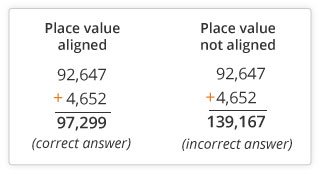
Sample problem 1: Addition with multi-digit numbers
Students also use place value to multiply and divide multi-digit numbers. They will be expected to multiply two-digit by two-digit numbers and up to four-digit by one-digit numbers, as well as divide up to four-digit numbers by one-digit numbers.
Sample problem 2: Multiplication with multi-digit numbers
Sample problem 3: Division with multi-digit numbers
In third grade, students learned that fractions are a part of a whole and can be placed on a number line by size. In fourth grade, students learn to add and subtract fractions with the same denominator (bottom number), and to multiply a fraction by a whole number. Students need to be proficient in these skills by the end of fourth grade because in fifth grade they’ll move on to adding and subtracting fractions with different denominators as well as dividing fractions by whole numbers, and vice versa.
Watch fourth graders doing word problems that involve fractions.

Sample problem 4: Adding and subtracting fractions
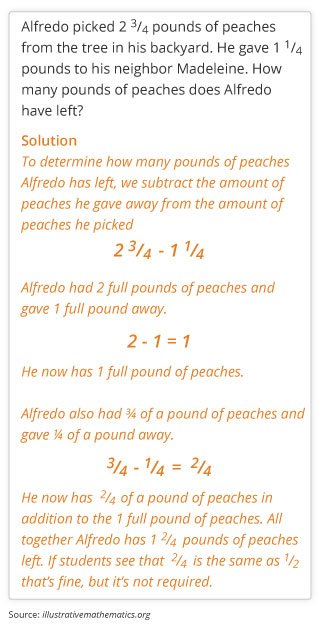
Fourth graders also need to be able to multiply a fraction by a whole number.
Sample problem 5: Multiplying a fraction by a whole number
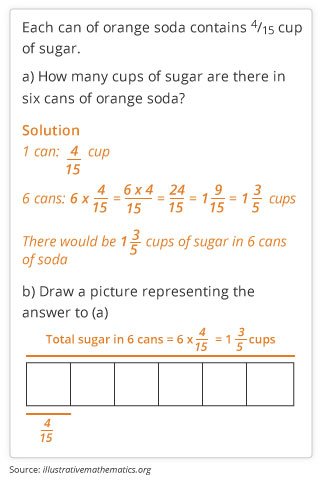
The next question requires students to show fractions with different denominators and numerators and describe why two fractions with different denominators can have the same value.
Sample problem 6: Finding equivalent fractions
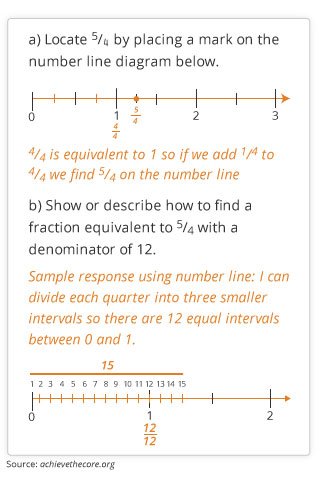
Students are also asked to compare fractions by creating visual fraction models or finding common denominators or numerators (bottom number and top number).
Sample problem 7: Comparing fractions
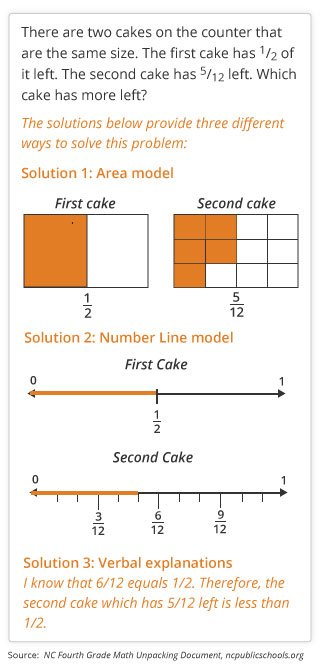
In fourth grade, students also learn about decimals by rewriting fractions with a denominator of 10 or 100 in decimal notation. For example, 6/10 becomes .6 and 6/100 becomes .06.
Sample problem 8: Decimal notation for fractions
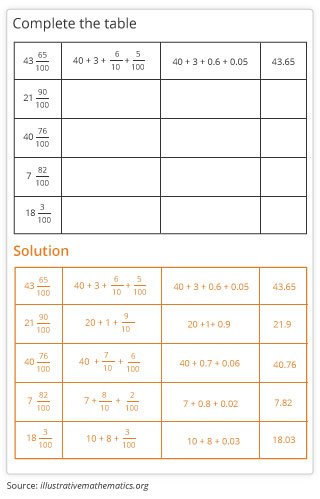
Attitude is contagious, so make sure yours is positive when talking to your child about math. There’s actually research showing that kids with “math-anxious” parents learn less than their classmates, and become more anxious about math themselves.
Ask your child’s teacher what specific math skills your child is struggling with and how you can help. Tell the teacher about activities outside of school that your child enjoys and ask if there’s a way to work math into those activities.
We all know it’s important for kids to master basic procedures such as multiplication and division. But math is more than memorizing facts or even procedures. Math also teaches an essential skill: problem solving. Kids learn problem solving when the path to solving the problem isn’t clear. To do this, kids need to learn skills that include modeling and data analysis.
Sound complicated? Actually, we do it every day. Modeling and data analysis means taking a real-world problem and using math to solve it — with a graph, an equation, a table, or a drawing. For example, a problem like If you want to devote ⅓ of a 20 by 30 foot backyard to a vegetable garden, how many square feet would it need to be? could be solved using an equation or by drawing the backyard to scale and dividing the rectangle. This would be an example of using modeling to solve a real-world problem.
Fourth graders learn how to apply the math they know to solve problems in everyday life and to make sense of problems and persevere in solving them. The test questions designed to measure these skills require students to be able to identify the important information in problems and figure out which steps to take and what tools to use (examples: pictures, graph paper, ruler) to find the answer. The following problem tests whether students can break down a multi-step problem and use pictures or equations involving multiplication to solve it.
Sample problem 1: Solving real-life, multi-step problems
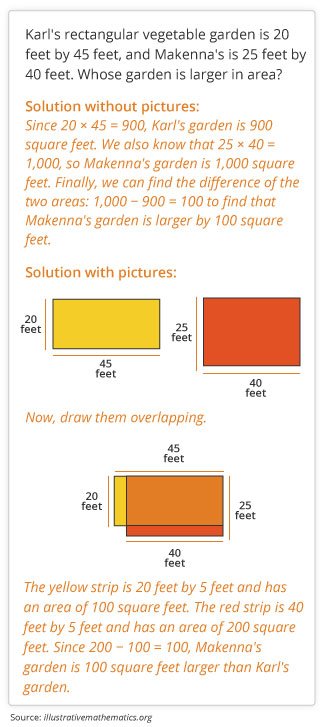
The problem below asks students to make sense of the data in the chart and use it to find the answer.
Sample problem 2: Analyzing and using data from a chart
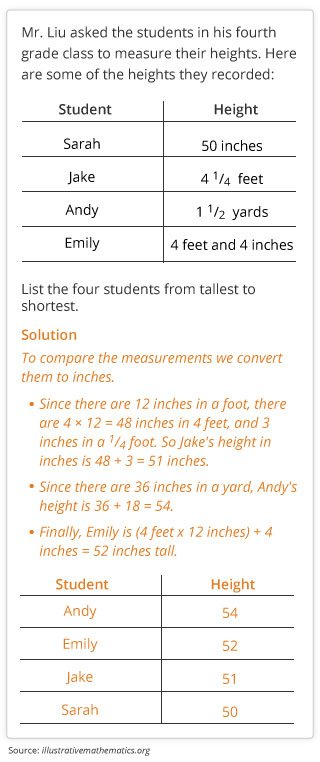
Be enthusiastic about how great problem solving skills will allow your child to do more cool things on her own. Does she enjoy building things? Is she trying to raise money to buy something? Isn’t it nice when she can figure things out without your help? The more kids see the practical side of math, the more exciting it becomes.
Ask your child’s teacher how you can help your child identify flaws in mathematical reasoning. Find out what questions you could ask your child to get him to focus on places where he tends to make mistakes. Ask the teacher to point out examples in your child’s work where he struggled with a concept so you’ll have a better understanding of how to help.
When students explain and defend their work, they can’t simply say, “I just know that it’s right!” Fourth graders need to be able to explain their work and defend their answers using words, charts, graphs, diagrams, and drawings to illustrate the steps they took. Students should be able to recognize when their reasoning has gone astray and explain the flaws in their logic. They also may be asked to critique their classmates’ work.
The new standards ask students to understand how math works and why. If students have only been taught how to solve a problem using a certain procedure, they may be stumped when faced with a problem that doesn’t give them that step-by-step information. Fourth graders should be able to talk through their thinking and explain why something is true using words or pictures.
Sample problem 1: Explaining reasoning
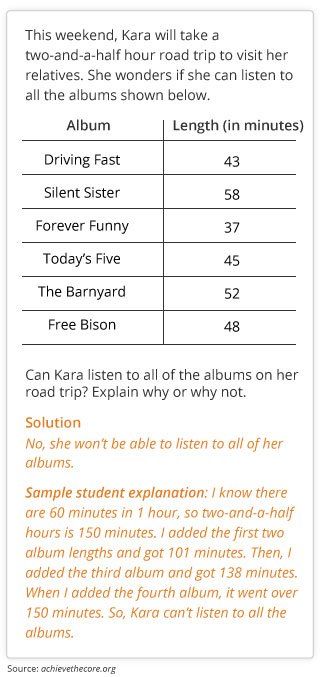
Teachers might use a question like the next one to figure out which students fully understand the concepts in the problem. To answer this question correctly, students need to know that ½ represents part of a whole and that half of something large is not equal to half of something small.
Sample problem 2: Critiquing the reasoning of others
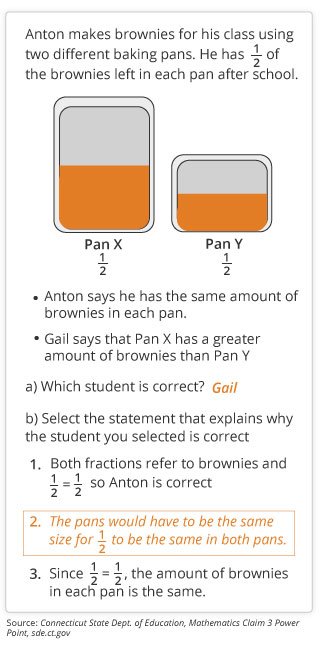
Research shows that confidence matters when it comes to math. When kids see themselves as capable at math, it boosts their willingness to stick with difficult problems. On the other hand, it’s not useful for kids to consider themselves “brilliant.” Overconfidence leads kids to shy away from difficult problems. How can you help? Make sure your child hears from you that she can learn math and be good at it, but it may take some effort.
GreatKids created this guide to help you understand your child's state test scores and to support your child's learning all year long. We worked with SBAC and leading teachers in every grade to break down what your child needs to know and exactly how you can help